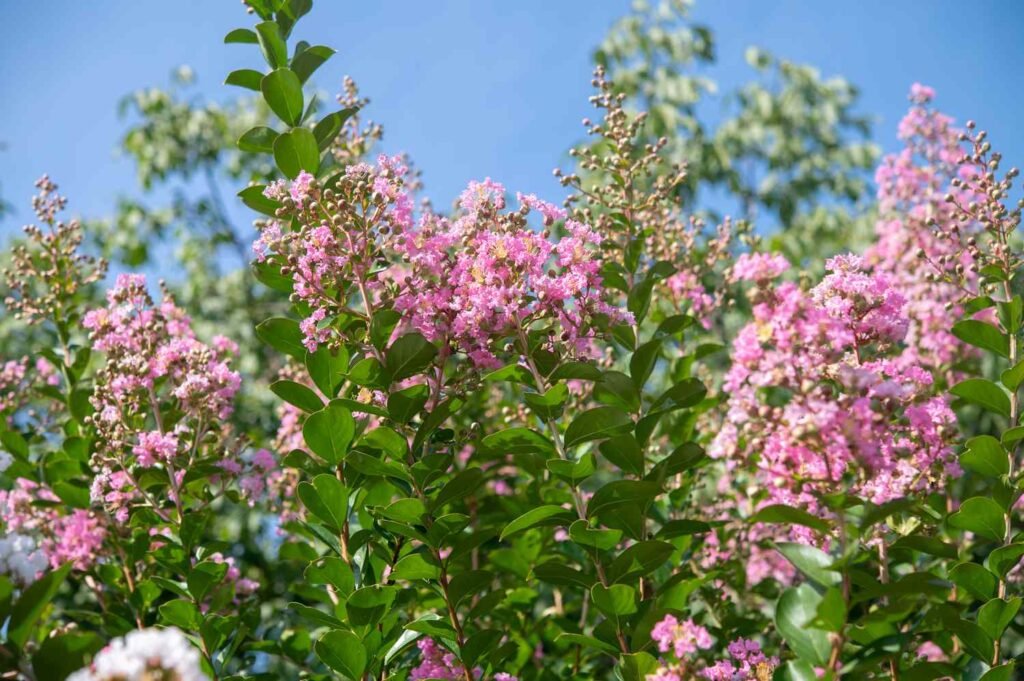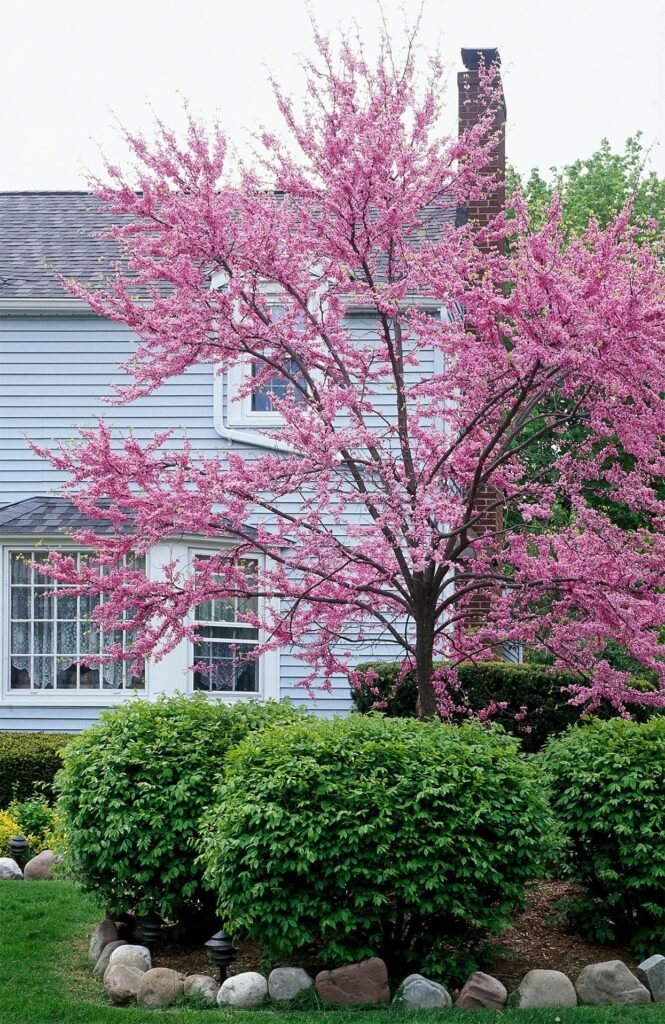Gardening in limited spaces presents unique challenges—and opportunities. While large, sprawling trees offer grandeur, they are often unsuitable for small gardens where space, sunlight, and aesthetics must be carefully balanced. Enter the realm of compact, flowering trees: nature’s perfect blend of beauty and practicality. These trees offer vibrant seasonal color, manageable growth, and ecological benefits without overwhelming confined areas. This article explores five flowering trees ideally suited for small gardens, highlighting their characteristics, care requirements, and unique contributions to landscape design.
1. Crape Myrtle (Lagerstroemia indica)

Overview:
The Crape Myrtle, often dubbed the “Lilac of the South,” is prized for its long-lasting summer blooms, attractive bark, and colorful autumn foliage. Originating in Asia but widely cultivated in warmer regions across the world, this tree has gained popularity due to its adaptability and striking appearance.
Key Characteristics:
- Height/Spread: 6 to 20 feet tall (dwarf cultivars available as small as 3-5 feet)
- Bloom Time: Mid-summer to early autumn
- Flower Colors: Pink, red, white, lavender, and purple
- USDA Zones: 6 to 10
Why It’s Perfect for Small Gardens:
Crape Myrtle’s multiple cultivars allow gardeners to select the perfect size and color. Dwarf and semi-dwarf varieties, such as ‘Chickasaw’ or ‘Pocomoke,’ grow compactly and can even be grown in containers. Its multi-season interest—blooming flowers in summer, vivid foliage in fall, and exfoliating bark in winter—adds year-round visual appeal in limited spaces.
Care Tips:
- Requires full sun for optimal blooming
- Tolerant of drought once established
- Light pruning in late winter encourages fuller blooms
2. Japanese Maple (Acer palmatum)

Overview:
Japanese Maple is a slow-growing ornamental tree renowned for its elegant form and stunning foliage. Though not always flowering in a traditional sense, many cultivars produce delicate spring flowers followed by vibrant red, orange, or purple leaves.
Key Characteristics:
- Height/Spread: 6 to 15 feet tall
- Bloom Time: Spring (small red to purplish flowers)
- Leaf Color: Varies by cultivar—red, green, variegated
- USDA Zones: 5 to 9
Why It’s Perfect for Small Gardens:
Its graceful, architectural shape and range of sizes make it ideal for intimate spaces. Varieties such as ‘Crimson Queen’ and ‘Tamukeyama’ are compact, weeping forms that enhance patios and Zen-style gardens. Japanese Maples add subtle color and elegance without overpowering surrounding plantings.
Care Tips:
- Prefers partial shade, especially in hotter climates
- Requires well-draining, slightly acidic soil
- Mulching helps retain moisture and protect roots
3. Eastern Redbud (Cercis canadensis)

Overview:
A herald of spring in North America, the Eastern Redbud is a small deciduous tree covered with profuse magenta-pink flowers before its leaves emerge. Native to woodlands and stream banks, it adapts well to urban and suburban environments.
Key Characteristics:
- Height/Spread: 15 to 25 feet tall
- Bloom Time: Early spring (March-April)
- Flower Color: Magenta, pink, or white
- USDA Zones: 4 to 9
Why It’s Perfect for Small Gardens:
Redbud’s compact growth and early-season flowers bring much-needed color after winter. Its heart-shaped leaves and attractive branching pattern add ornamental interest even after blooming. Cultivars like ‘Forest Pansy’ (with deep purple foliage) or ‘Ruby Falls’ (a dwarf, weeping form) offer additional variety for space-conscious gardeners.
Care Tips:
- Thrives in full sun to light shade
- Tolerates a range of soils but prefers moist, well-drained conditions
- Prune after flowering to shape and remove dead wood
4. Fringe Tree (Chionanthus virginicus)

Overview:
Often described as one of the most beautiful native flowering trees in the United States, the Fringe Tree produces delicate, fragrant white blooms resembling fringe or lace in late spring. It is a lesser-known gem, perfect for garden enthusiasts seeking unique specimens.
Key Characteristics:
- Height/Spread: 12 to 20 feet tall
- Bloom Time: Late spring to early summer
- Flower Color: White (male trees are showier bloomers)
- USDA Zones: 3 to 9
Why It’s Perfect for Small Gardens:
Fringe Tree’s slow growth and compact size make it well-suited to limited garden spaces. Its fragrant flowers attract pollinators, while its golden-yellow fall color provides a seasonal finale. The tree’s adaptable nature allows it to fit into various garden styles, from woodland to cottage.
Care Tips:
- Prefers full sun to partial shade
- Thrives in moist, well-drained, slightly acidic soils
- Minimal pruning required—generally pest and disease resistant
5. Dwarf Flowering Cherry (Prunus serrulata var. ‘Snow Fountain’ or ‘Kwanzan’)

Overview:
Dwarf flowering cherry trees encapsulate the delicate beauty of cherry blossoms within a size suitable for urban and small garden settings. ‘Snow Fountain’ is a weeping variety known for its graceful form and snowy-white spring blooms, while ‘Kwanzan’ features larger pink flowers and a more upright habit.
Key Characteristics:
- Height/Spread: 8 to 15 feet tall (depending on cultivar)
- Bloom Time: Early to mid-spring
- Flower Color: White or double-pink
- USDA Zones: 5 to 9
Why It’s Perfect for Small Gardens:
These ornamental cherries bloom early and abundantly, creating a dramatic spring spectacle without requiring a large footprint. Their elegant silhouette and manageable height make them ideal as a focal point or accent tree in compact yards or courtyard gardens.
Care Tips:
- Requires full sun for best flowering
- Well-draining soil is essential; avoid heavy clay
- Prune after flowering to maintain shape
Benefits of Flowering Trees in Small Gardens
Integrating flowering trees into small gardens offers a variety of practical and aesthetic benefits:
- Seasonal Interest: With strategic planning, trees can provide year-round beauty—flowers in spring, lush foliage in summer, vibrant leaves in fall, and textured bark in winter.
- Ecological Value: These trees offer nectar and shelter for pollinators like bees, butterflies, and birds, contributing to urban biodiversity.
- Shade and Microclimate Control: Properly placed trees can create shade, reduce heat, and protect understory plants from sun and wind.
- Privacy and Structure: Smaller trees can form natural screens and help define garden “rooms” without the permanence or maintenance of built structures.
Conclusion
Flowering trees bring vibrant color, structure, and life to any landscape—but they are especially vital in small gardens where every element must be both functional and beautiful. Trees such as the Crape Myrtle, Japanese Maple, Eastern Redbud, Fringe Tree, and Dwarf Flowering Cherry exemplify how nature’s artistry can be scaled to fit modest spaces. By choosing species suited to specific climates, light conditions, and soil types, gardeners can cultivate intimate green sanctuaries that bloom brilliantly throughout the year.
Small gardens need not sacrifice grandeur—only embrace it in miniature.
